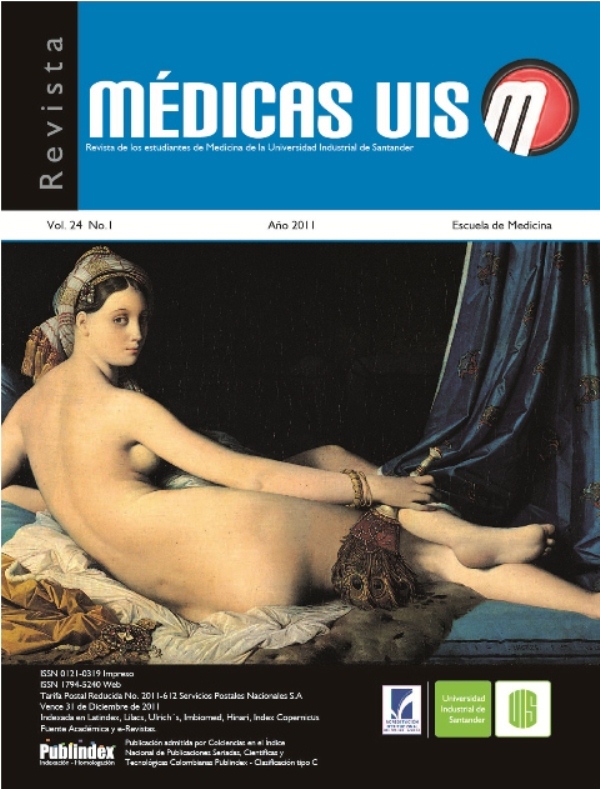Abstract
Microbiological characterization of Salmonella in Street-vended foods an university sector in Bogotá, Colombia. julyoctober2010Introduction. Salmonella belongs to the Enterobacteriaceae family, and is one of the main microorganisms involved in foodbornedisease. It produces a clinical entity known as salmonelosis can manifest as two different pathological processes, typhoid feveror gastroenteritis. The objective of this research was to demonstrate the presence of Salmonella spp. in street-vended foodsin an area bounded by Universities in the city of Bogotá and its subsequent characterization by means of clinical microbiologytechniques. Materials and Methods. Observational cross sectional study. Was analyze 42 samples of street-vended foods obtainedthrough a non-probability sampling, the isolation of Salmonella spp. was performed following the method proposed by the Foodand Drug Administration, performing biochemical identification and serological tests for Salmonella spp. and antimicrobialsusceptibility testing. Results. Growth was detected in a total of 18 samples (42.9%), of which only 2 were positive for Salmonellaenterica with a 11.1%, 11 out of 18 samples were positive for other bacteria belonging to the family Enterobacteriaceae (61.1%)and 5 samples without profile identified (27.8%). The samples tested were susceptible to ciprofloxacin susceptibility, showingresistance to Trimethoprim-Sulfamethoxazole, Chloramphenicol and Ampicillin. Conclusions. This investigation established thepresence of Salmonella enterica and other Enterobacteriaceae in street-vended foods, showing a high risk to the health ofresidents and student population of a university sector in the city of Bogotá, Colombia.
Key words: Salmonella. Foodborne Diseases. Serotyping.
References
2. Dunkley KD, Callaway TR, Chalova VI, McReynolds JL, Hume ME, et al. Foodborne Salmonella ecology in the avian gastrointestinal tract. Anaerobe. 2009;15(1-2):26–35.
3. Uribe C, Suárez M. Salmonelosis no tifoidea y su transmisión a través de alimentos de origen aviar. Colomb Med. 2006;37(2):151-8.
4. Pigott D. Foodborne Illness. Emerg Med Clin N Am. 2008;26(2):475–97.
5. Gordon MA. Salmonella infections in immunocrompromised adults. J Infect. 2008;56(6):413-22.
6. Greig JD, Ravel A. Analysis of foodborne outbreak data reported internationally for source attribution. Int J Food Microbiol. 2009;130(2):77–87.
7. Newell D, Koopmans M, Verhoef L, Duizer E, Aidara-Kane A, Sprong H, et al. Food-borne diseases - the challenges of 20 years ago still persist while new ones continue to emerge. Int J Food Microbiol. 2010;139(Suppl 1):S3–S15.
8. Alvarez CJ, Chávez JA, Guerrero JA, López MP, Espinosa J. Informe de vigilancia de las enfermedades transmitidas por alimentos, año 2008, Colombia. Informe Epidemiológico Enfermedades Transmitidas por Alimentos. Periodo Epidemiológico XIII de 2008 INS. V 22.04.2009.
9. Semana epidemiológica 43 año 2010, Colombia, SIVIGILA. Instituto Nacional de Salud. [Consultado: noviembre de 2010]. Disponible en: http://www.ins.gov.co/?idcategoria=81738#.
10. Marin P, Prieto EP, Otero V, Mattar S. Presencia del gen de invasividad invA en cepas de Salmonella spp. aisladas de alimentos del caribe colombiano. Rev Cub Salud Pub. 2006;32(2):115-20.
11. Cardona NM, Sánchez MM, Usuga LY, Arboleda M, Garzón E, Vélez A, y cols. Caracterización de dos brotes de fiebre tifoidea en Apartadó, Antioquia, 2005. Biomédica. 2007;27(2):236-43.
12. Cetinkaya F, Cibik R, Soyutemiz E, Ozakin C, Kayali R, Levent B. Shigella and Salmonella contamination in various foodstuffs in Turkey. Food Cont. 2008;19(11):1059-63.
13. Ulloa J, González M, Hernández C, Villanueva MP, Fernández H. Salmonella enteritidis in chicken carcasses and giblets in southern Chile. J Infect Dev Ctries. 2010;4(2):107-9.
14. Salmonella enteritidis outbreak. Food and Drug Administration. [Consultado: noviembre de 2010]. Disponible en: http://www.fda.gov/Food/NewsEvents/WhatsNewinFood/ucm222684.htm
15. Microbiological methods. Food and Drug Administration. [Consultado: noviembre de 2010]. Disponible en: http://www.fda.gov/Food/ScienceResearch/LaboratoryMethods/ucm114664#fda
16. Méndez I, Mossos N, Mogollon D, Mattar S, Poutou R. Epidemiological relationship among strains of Salmonella enterica subsp. enteric isolated from humans, poultry and food. Univ. Sci. 2006;11(1):5-13.
17. Andrews HL, Santiviago CA, McClelland M. Novel genetic tools for studying food-borne Salmonella. Curr Opin Biotechnol. 2009;20(2):149-57.
